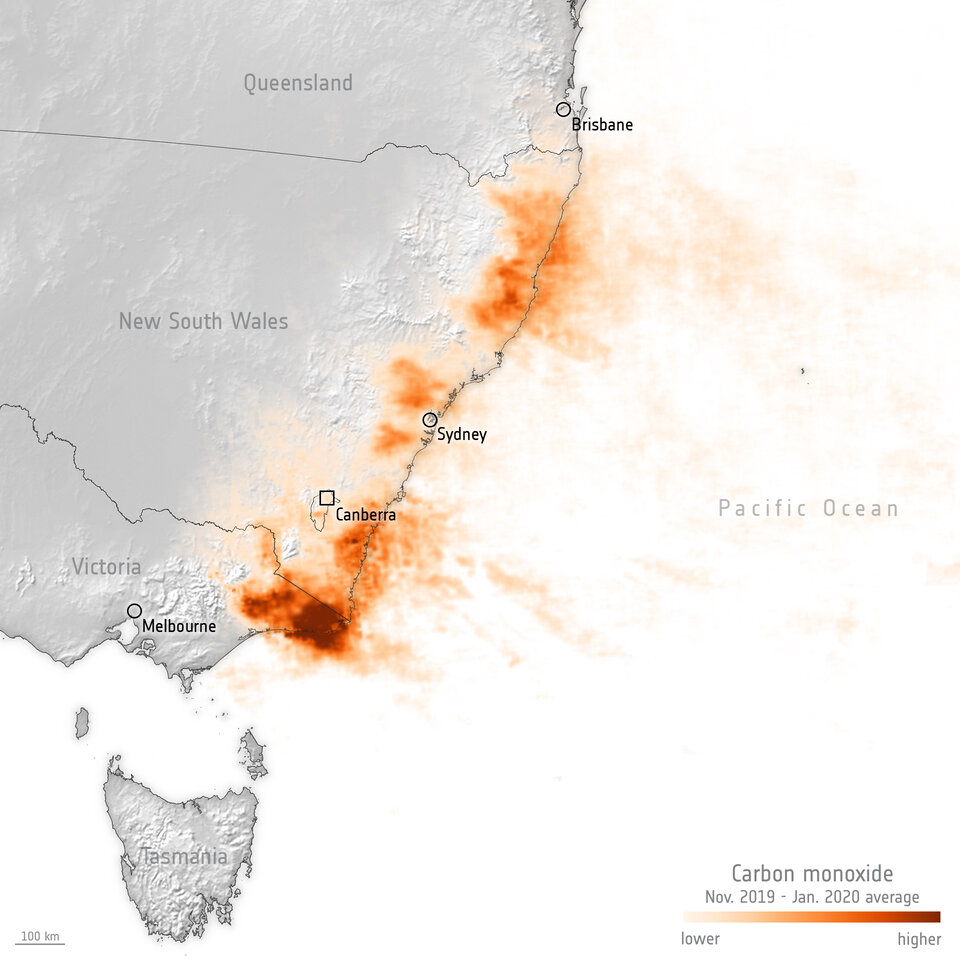Australia’s deadly bushfires in the 2019-2020 season generated 700 million tonnes of carbon dioxide in the atmosphere – triggering vast algal blooms in the Southern Ocean. Using satellite data, two new studies published in Nature prove how satellites can illuminate the complicated ways in which Earth is responding to climate change in an era of worsening wildfires.
Australia is no stranger to bushfires, however the 2019-2020 season proved to be unprecedented. As of March 2020, the fires burned an estimated 18.6 million hectares (or 186 000 sq km) destroying over 5000 buildings and killed over 400 people. It was estimated that more than a billion animals perished from the bushfires, with several endangered species facing the risk of total extinction.
Based on a new paper, published in Nature, the extreme bushfires across southeast Australia released 715 million tonnes of carbon dioxide into the air – more than double the emissions provided by fire emission inventory datasets.
In southeast Australia, the fires were both intense and extensive. As much as 74 000 sq km of mostly eucalyptus forest, roughly 2.5 times the area of Belgium, was affected. Previous estimates from global inventory datasets of wildfire emissions based on satellite fire data and modelled quantities of standing biomass suggested that the fires released on average 275 million tonnes of carbon dioxide between November 2019 and January 2020.
However, the new analysis indicates that this figure was a gross underestimate. Using data from the Tropomi instrument on board the Copernicus Sentinel-5P satellite, the research team were able to obtain a more accurate estimate of the emissions.
While Tropomi doesn’t directly measure carbon dioxide, the instrument takes daily snapshots of carbon monoxide levels in the atmospheric column beneath it. The research team used these data to calculate a more detailed estimate of the carbon monoxide emissions from the bushfires, which they used as a proxy for calculating carbon dioxide emissions.
The team were able to then conclude that the bushfires released 715 million tonnes in just three months. This is twice the amount of carbon dioxide that had previously been suggested by fire inventory estimates and surpasses Australia’s normal annual bushfire and fossil fuel emissions by 80%.
Ivar R. van der Velde, an environmental scientist at the SRON Netherlands Institute for Space Research, in Utrecht, and at the Vrije Universiteit Amsterdam, commented, “The Tropomi data of atmospheric carbon monoxide concentrations provide us with invaluable information on all kinds of wildfires around the world. When the Australian fires raged in December 2019, we immediately sense that there was very interesting science hidden in the vast amount of Tropomi data.
“The disastrous impact the fires had on the local population and local air quality was already known. What we didn’t know yet was the magnitude of the pollutants and greenhouse gases emitted by the fires.”Aerosol spread from Australian fires
Droughts, driven by climate change, are causing an increased frequency and intensity of wildfires. These have been a global problem since the fires release such an enormous quantity of carbon dioxide in the atmosphere, further driving climate change and raising global temperatures, driving a perpetual feedback loop.
The question then remains: what happens to all this carbon dioxide emitted in the long-term?
Another recent paper, also published in Nature, suggests that the aerosols generated by the record Australian bushfire season were ‘sucked up’ by a gigantic phytoplankton bloom thousands of kilometres away in the Pacific Southern Ocean.
The paper found that during the fires, vast plumes of smoke which are rich in nutrients, were swept away over the ocean. Within days, these aerosols had infused the waters with iron, nourishing phytoplankton – microscopic plants – which then absorbed carbon dioxide equivalent to as much as 95% of the emissions from the fires.
Phytoplankton are known to help remove carbon dioxide from the atmosphere, as these tiny organisms consume carbon dioxide during photosynthesis. These extensive phytoplankton blooms are said to have covered an area approximately the size of the Sahara Desert, more than 9.4 million sq km.
The researchers monitored aerosol plumes using data from the Copernicus Atmosphere Monitoring Service (CAMS) which include aerosol information from NASA’s Moderate Resolution Imaging Spectroradiometer (MODIS). They then compared the aerosol observations to ocean chlorophyll concentrations recording by ESA’s Ocean Colour Climate Change Initiative project and found peaks in chlorophyll concentrations a few days to weeks later.
Thomas Jackson, an Ocean Colour Scientist at Plymouth Marine Laboratory (PML), and a member of ESA’s Ocean-Colour Climate Change Initiative, commented, “It was an honour to work with this group of international scientists on such an interdisciplinary problem, with each one bringing their expertise to put the whole story together.
“The phytoplankton response to the fallout of the Australian wildfires was impressive in terms of both its geographical extent and the magnitude of the anomaly. Phytoplankton have long been considered sentinels of change, responding at both short and long timescales to changes in the physical and chemical state of the oceans. It will be interesting to see if ‘megablooms’ such as these become more common, and what the ecological impacts of such blooms could be, as wildfires and other extreme environmental events become more frequent as a result of climate change.”
Shubha Sathyendranath, also from PML and ESA’s Ocean Colour Climate Change Initiative project, added, “This work highlights the intricate interplay among various components of Earth’s climate system. The paper shows how fire, aerosols, winds and phytoplankton interact with each other across thousands of kilometres.”
The findings from both studies highlight the significance of wildfires on atmospheric carbon dioxide concentrations but also how they can directly influence ocean processes. However, more research needs to be undertaken to understand where the carbon taken up by the plankton eventually goes and whether this is re-released into the atmosphere.








